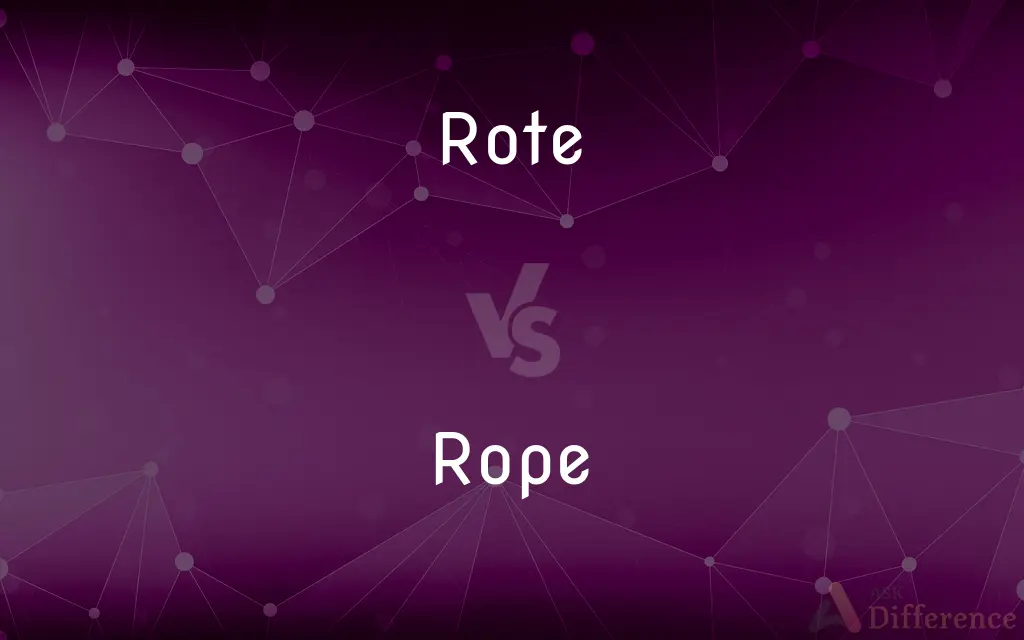Rote vs. Rope — What's the Difference?
Edited by Tayyaba Rehman — By Urooj Arif — Updated on March 10, 2024
Rote refers to memorization by repetition, often without understanding, while rope is a long, thick cord made from strands twisted or braided together, used for tying, binding, or pulling.

Difference Between Rote and Rope
Table of Contents
ADVERTISEMENT
Key Differences
Rote learning is a technique based on repetition and memorization. It is commonly used for learning facts, figures, or formulas where understanding the underlying concepts might not be emphasized. This method is often critiqued for its lack of depth in comprehension, as learners might remember information for tests without truly grasping its meaning. On the other hand, rope is a physical object, essential in various applications such as construction, navigation, sports, and survival. It is made from materials like hemp, nylon, or polypropylene, designed to be durable and flexible.
The primary difference lies in their nature and use, rote is a method of learning, focusing on repetition, whereas rope is a tangible item with practical uses. Rote learning can be beneficial for mastering foundational knowledge quickly, but it may not foster critical thinking or deep understanding. Conversely, a rope's significance lies in its physical properties and its utility in tasks requiring binding, lifting, or securing.
Educational strategies often seek alternatives to rote learning to encourage analytical thinking and problem-solving skills. In contrast, the innovation in rope manufacturing focuses on improving its strength, durability, and versatility for various applications, from mountain climbing to marine navigation.
Both rote learning and ropes have historical significance. Rote learning has been a traditional educational method for centuries, used in everything from language acquisition to religious teaching. Similarly, ropes have been indispensable tools throughout human history, evolving from natural fibers to synthetic materials to meet the demands of advanced technologies and industries.
Despite their differences, both concepts highlight the importance of foundational tools and methods in their respective fields rote learning in education and rope in physical tasks. Effective education balances rote memorization with critical thinking, just as technological advancements balance the traditional uses of rope with innovative applications.
ADVERTISEMENT
Comparison Chart
Definition
Memorization technique based on repetition
Long, thick cord made from twisted or braided strands
Nature
Learning method
Physical object
Use
Learning facts or figures without deep understanding
Tying, binding, pulling, or securing
Critique
Lacks depth in comprehension
N/A
Benefits
Quick memorization
Versatility and utility in various applications
Material
N/A
Hemp, nylon, polypropylene, etc.
Focus
Repetition
Durability, flexibility
Historical Significance
Traditional educational method
Indispensable tool in human history
Compare with Definitions
Rote
Often lacks understanding.
He passed the test by rote learning but struggled with applying concepts.
Rope
Used in various industries.
Ropes are essential in maritime navigation for securing ships.
Rote
Learning by repetition.
Memorizing multiplication tables through rote helps in quick recall.
Rope
Essential for survival tasks.
Knowing how to tie knots in a rope can be a critical survival skill.
Rote
Focused on memorization.
Rote learning is effective for languages' vocabulary acquisition.
Rope
Evolved over time.
Advances in materials have significantly improved rope's strength and flexibility.
Rote
Critiqued for superficiality.
Critics argue that rote learning undermines critical thinking skills.
Rope
Made from various materials.
Synthetic ropes offer greater durability and resistance to elements.
Rote
Used in traditional education.
Rote was the primary method for learning ancient texts.
Rope
Twisted strands for strength.
The climber relied on the rope for safety during the ascent.
Rote
A memorizing process using routine or repetition, often without full attention or comprehension
Learn by rote.
Rope
A rope is a group of yarns, plies, fibers or strands that are twisted or braided together into a larger and stronger form. Ropes have tensile strength and so can be used for dragging and lifting.
Rote
Mechanical routine.
Rope
A flexible heavy cord of tightly intertwined hemp or other fiber.
Rote
The sound of surf breaking on the shore.
Rope
A string of items attached in one line, especially by twisting or braiding
A rope of onions.
Rote
A medieval stringed instrument variably identified with a lyre, lute, or harp.
Rope
A sticky glutinous formation of stringy matter in a liquid.
Rote
Mechanical routine; a fixed, habitual, repetitive, or mechanical course of procedure.
The pastoral scenes from those commercials don’t bear too much resemblance to the rote of daily life on a farm.
He could perform by rote any of his roles in Shakespeare.
Rope
A cord with a noose at one end for hanging a person.
Rote
(rare) The roar of the surf; the sound of waves breaking on the shore.
Rope
A lasso or lariat.
Rote
(musical instrument) A kind of guitar, the notes of which were produced by a small wheel or wheel-like arrangement; an instrument similar to the hurdy-gurdy.
Rope
Ropes(Sports) Several cords strung between poles to enclose a boxing or wrestling ring.
Rote
Synonym of crowd.
Rope
Ropes(Informal) Specialized procedures or details
Learn the ropes.
Know the ropes.
Rote
By repetition or practice.
Rope
(Baseball) A line drive.
Rote
(obsolete) To go out by rotation or succession; to rotate.
Rope
To tie, fasten, or attach with a rope or other cord.
Rote
(transitive) To learn or repeat by rote.
Rope
To enclose, separate, or partition with a rope or other cord
Rope off the scene of the crime.
Rote
A root.
Rope
To catch with a rope or lasso.
Rote
A kind of guitar, the notes of which were produced by a small wheel or wheel-like arrangement; an instrument similar to the hurdy-gurdy.
Well could he sing and play on a rote.
Extracting mistuned dirges from their harps, crowds, and rotes.
Rope
(Informal) To persuade or manipulate (someone)
My boss roped me into attending the ceremony.
Rote
The noise produced by the surf of the sea dashing upon the shore. See Rut.
Rope
(uncountable) Thick strings, yarn, monofilaments, metal wires, or strands of other cordage that are twisted together to form a stronger line.
Nylon rope is usually stronger than similar rope made of plant fibers.
Rote
A frequent repetition of forms of speech without attention to the meaning; mere repetition; as, to learn rules by rote.
Till he the first verse could [i. e., knew] all by rote.
Thy love did read by rote, and could not spell.
Rope
(countable) An individual length of such material.
The swinging bridge is constructed of 40 logs and 30 ropes.
Rote
To learn or repeat by rote.
Rope
A cohesive strand of something.
The duchess wore a rope of pearls to the soirée.
Rote
To go out by rotation or succession; to rotate.
Rope
A shot of semen that a man releases during ejaculation.
Rote
Memorization by repetition
Rope
(dated) A continuous stream.
Rope
(baseball) A hard line drive.
He hit a rope past third and into the corner.
Rope
(ceramics) A long thin segment of soft clay, either extruded or formed by hand.
Rope
(computer science) A data structure resembling a string, using a concatenation tree in which each leaf represents a character.
Rope
A kind of chaff material dropped to interfere with radar consisting of foil strips with paper chutes attached.
Rope
(Jainism) A unit of distance equivalent to the distance covered in six months by a god flying at ten million miles per second.
Rope
(jewelry) A necklace of at least 1 meter in length.
Rope
(nautical) Cordage of at least 1 inch in diameter, or a length of such cordage.
Rope
(archaic) A unit of length equal to 20 feet.
Rope
(slang) Rohypnol.
Rope
Semen being ejaculated.
Rope
(in the plural) The small intestines.
The ropes of birds
Rope
(transitive) To tie (something) with rope.
The robber roped the victims.
Rope
(transitive) To throw a rope (or something similar, e.g. a lasso, cable, wire, etc.) around (something).
The cowboy roped the calf.
Rope
(intransitive) To climb by means of a rope or ropes.
Rope
(intransitive) To be formed into rope; to draw out or extend into a filament or thread.
Rope
To commit suicide, particularly by hanging.
My life is a mess; I might as well rope.
Rope
A large, stout cord, usually one not less than an inch in circumference, made of strands twisted or braided together. It differs from cord, line, and string, only in its size. See Cordage.
Rope
A row or string consisting of a number of things united, as by braiding, twining, etc.; as, a rope of onions.
Rope
The small intestines; as, the ropes of birds.
Rope
To be formed into rope; to draw out or extend into a filament or thread, as by means of any glutinous or adhesive quality.
Let us not hang like ropingiciclesUpon our houses' thatch.
Rope
To bind, fasten, or tie with a rope or cord; as, to rope a bale of goods.
Rope
To connect or fasten together, as a party of mountain climbers, with a rope.
Rope
To partition, separate, or divide off, by means of a rope, so as to include or exclude something; as, to rope in, or rope off, a plot of ground; to rope out a crowd.
Rope
To lasso (a steer, horse).
Rope
To draw, as with a rope; to entice; to inveigle; to decoy; as, to rope in customers or voters.
Rope
To prevent from winning (as a horse), by pulling or curbing.
Rope
A strong line
Rope
Street names for flunitrazepan
Rope
Catch with a lasso;
Rope cows
Rope
Fasten with a rope;
Rope the bag securely
Common Curiosities
What is rote learning?
Rote learning is a memorization technique based on repetition, often used for quickly learning facts or figures without deep understanding.
Why is rote learning criticized?
It is criticized for focusing on memorization without fostering a deep understanding or critical thinking skills.
What are the uses of a rope?
Ropes are used for tying, binding, pulling, or securing objects in various applications, including construction, navigation, and sports.
Is there a place for rote learning in modern education?
While modern education emphasizes understanding and critical thinking, rote learning still has a place for certain types of foundational knowledge.
What are the benefits of using synthetic ropes?
Synthetic ropes offer benefits like higher strength, lighter weight, and resistance to water and UV damage.
What materials are ropes made from?
Ropes can be made from natural fibers like hemp or synthetic materials like nylon and polypropylene.
Can rote learning be effective?
Yes, rote learning can be effective for mastering foundational knowledge or information that requires quick recall.
How do you choose the right type of rope for a task?
The choice depends on the task's requirements, including the rope's strength, flexibility, and resistance to environmental factors.
How has the manufacture of ropes evolved?
Rope manufacture has evolved from using natural fibers to incorporating synthetic materials, improving strength, durability, and flexibility.
How can educators balance rote learning and critical thinking?
Educators can balance the two by using rote learning for foundational knowledge and encouraging analytical and problem-solving activities for deeper understanding.
Share Your Discovery

Previous Comparison
Transfer vs. Transaction
Next Comparison
Camping vs. LampingAuthor Spotlight
Written by
Urooj ArifUrooj is a skilled content writer at Ask Difference, known for her exceptional ability to simplify complex topics into engaging and informative content. With a passion for research and a flair for clear, concise writing, she consistently delivers articles that resonate with our diverse audience.
Edited by
Tayyaba RehmanTayyaba Rehman is a distinguished writer, currently serving as a primary contributor to askdifference.com. As a researcher in semantics and etymology, Tayyaba's passion for the complexity of languages and their distinctions has found a perfect home on the platform. Tayyaba delves into the intricacies of language, distinguishing between commonly confused words and phrases, thereby providing clarity for readers worldwide.














































